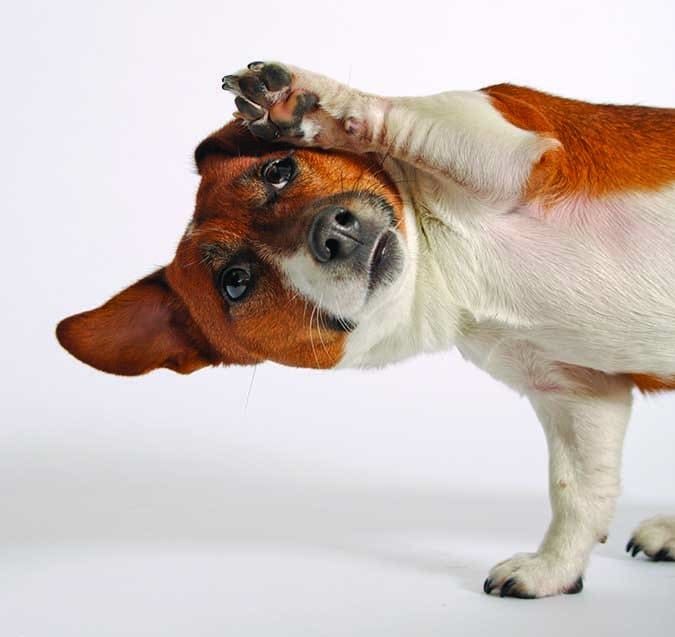[Updated February 6, 2019]
It’s fortunate that there are many positive training options for our dogs today! Increasingly, people are choosing to extend their dogs’ education past classes in good manners, and I strongly advocate following up those basic classes with a tricks class! Learning even just a few basic tricks is fun for you, your dog, and your potential audience! And while the benefits to you and your dog are many, I will describe my top five:
1. Trick Training Develops Patience.
Have you ever felt frustrated or lost your patience with your dog? Raised your voice or used coercion, or other training methods that made your dog uncomfortable? Guess what: You’re human! But your dog knows when you’re not pleased, and that’s likely to negatively affect his ability to learn, as well as potentially damage your relationship with him.

Training a dog to do fun (or funny!) tricks helps many owners let go of their expectations and just “be in the moment” of training their dog to do something in small steps. Perhaps it’s because the goal behaviors are “just tricks,” rather than behaviors that they feel their dogs must learn, lest they be judged as “bad owners”!
When you don’t expect instant results, it’s much easier to break down your training goal into a progression of small steps. This will make it much easier for your dog to succeed, you will be less likely to lose your patience, and the two of you will be much happier training together.
As an example, here’s how I taught my dog, Bella, to do a handstand. It took many steps and months to achieve, but the result was worth the effort and time.
First, she had to learn to back up. I had Bella standing in front of me. As I walked toward her she instinctively walked backward, and I marked the behavior with the “click” of a clicker and rewarded her. After enough repetitions, we had a nice “back” behavior.
The next step was getting her to back up and step with her rear feet onto something that was raised a little bit higher, and then, a little higher. I used pillows because they don’t slide away like a book might do, although large, heavy coffee-table books might have worked well). I placed the pillows next to a wall to keep them from sliding. Again, I accomplished this in a number of short sessions by marking and rewarding any of Bella’s increasingly correct efforts – a classic “shaping” technique.
Once Bella achieved a fairly vertical position, with her hind feet up on a quite high stack of pillows, I was able to ask her to back up to a wall in a spot where there were no pillows. Because we’ve done so much shaping, she was eventually able to figure out that the behavior that I would mark and reward was putting her rear feet on the wall. The repetition of backing and raising her rear legs gave her the strength and muscle memory to kick her back legs up and place them on the wall.
Each of these behaviors was practiced in numerous short training sessions. All the while, I was rewarding her with treats and loads of verbal praise, and she was slowly building endurance and gaining confidence. I mention strength because it is particularly important to not rush this trick. Think of it like this: If you were going to train for a marathon and hadn’t been running regularly, it might not be a wise idea to start running 10 miles right away. You could injure yourself because your muscles weren’t prepared for such an effort. However, when you run longer each week, your muscles slowly reach the level of conditioning that would lessen your chances of injury. When a dog does a handstand, he uses abdominal muscles that aren’t necessarily conditioned. Don’t be in a hurry!
To reiterate, when Bella was successful with the first step (backing), I stopped there. We had achieved our first goal, ended with positive results, and we were both happy. I got her to do what I wanted; I didn’t push it to the next level during that session.
As you can see, the process of learning a complicated or physically difficult trick can take some time. Keep your training sessions, particularly for a new trick, to a maximum of five to 10 minutes. Your dog will be less likely to get tired, bored, or frustrated – and you will be less likely to get frustrated. When you spend too much time on a particular part of a trick, especially if it’s not going smoothly, you may find yourself losing patience. Your dog will sense this and may become shy or timid, lose interest, or just shut down.
It’s okay to train more than once a day, but it’s best to space these short sessions out over several hours. Make sure to reward your dog and give lots of verbal praise. Your dog will have fun and be eager for the next training session. When I was teaching Bella her handstand, I only spent about five to 10 minutes on each new behavior. She could see I was pleased at the end of the session and was therefore so eager for the next training time that she often offered me the desired behavior before I asked for it. She learned in a stress-free manner and was ready to move on to the next step.
2. Trick Training is Fun for Both of You!
If you end your session on a positive note – and with tricks, it’s kind of hard not to, as it’s all fun and games! – you and your pup will walk away cheerful and satisfied.
I’m currently teaching my male dog, Mario, to jump in the air with a ball in his mouth. He knows how to take the ball in his mouth and he knows how to jump. I am trying to put the two together. When we’ve practiced, he’ll sometimes take the ball and then drop it at the jump cue. Or he’ll jump without picking the ball up at all.
However, he’s had moments of jumping with the ball in his mouth. When he achieves this behavior, I give him a jackpot – extra treats, fed one after another after another, and tons of verbal praise. Then I stop there. We are both genuinely thrilled about his success.
If you do not achieve your goal in a session, do your best to hide any frustration you may be feeling. Move on to a trick that your dog can already perform successfully and end with him receiving a nice reward. You can come back to the new trick later.
3. Trick Training Will Increase Your Dog’s Confidence.
Recently, an elated student in my tricks class told me that since she started teaching her dog tricks, the dog was showing signs of confidence, an interest in training, and an overall enthusiasm that my student had not seen before. She had no idea that this is often the case in tricks class!
For my part, I’ve noticed that Bella has gained confidence as she watches her brother, Mario. Mario is not afraid of moving objects and loves to ride a skateboard. When I first tried teaching the same trick to Bella, she was timid and reluctant to participate. After watching Mario do this trick over and over, on her own, with no prompting by me, she jumped on the skateboard to hitch a ride with him. Hooray! Now she insists on jumping on the board. She doesn’t yet push it on her own, but when I see that she’s ready, I may teach her to do this trick.
Mario also hops on top of and can balance on a rolling barrel; again, Bella used to be afraid of the moving barrel. Then, one day, she started going through the barrel. I reinforced this behavior, and with time, she gained the confidence to run in and out of this barrel while Mario is on top!
If your dog is a little timid, enrolling in a tricks class in your area may be a good idea. If your dog is in a room with other dogs doing tricks, he may gain confidence from even just watching the other dogs. If he’s like Bella, he’ll start to develop an interest in doing whatever is causing that upbeat, giddy behavior from the other dogs’ humans!
4. Trick Training Helps Your Dog with Distractions
Your dog will learn to work with distractions. Tricks classes present a dog with many distractions, but if you consistently reward your dog for watching you and listening for your cues, soon your dog will pay much less attention to extraneous stimuli in any setting when you ask him to focus.

This ability to focus on you will come in handy when walking outdoors; it even increases your dog’s safety while he is walking with you near busy streets or crowded areas.
5. Tricks Let Out Your Dog’s Excess Energy
Does your dog seem to have excess energy and you don’t know what to do with it? Trick training may be the answer. Jack Russell Terriers, as well as many other breeds, tend to have an extraordinary amount of energy, but I’ve found that trick training helps channel that energy into behavior that I enjoy more! Mario and Bella are very calm and well-behaved, and I credit their trick training with at least some of their good behavior.
Many dogs who are bored will display undesirable behaviors, such as chewing or barking, that could put them out of house and home. This energy can be put to good use. Redirecting your dog’s excess energy into fun tricks, and enthusiastically praising him for his efforts, will likely make him increase the behaviors that make you happy.
BONUS: Trick Training Strengthens Your Bond
Taking a little extra fun time with your dog and practicing patience will both strengthen the bond with your dog and produce unique, enjoyable results. If a holiday family event gets dull, you can “wow” your relatives and spice up the party by showing off your dog’s amazing tricks. Those of you who take your dog to senior centers or work with children can share the tricks with a very willing audience. Your dog will relish the extra attention! In the end, you and your dog will build a strong and trusting bond, and that is the best reward of all.
With her two Jack Russell Terriers, trainer Marian DeAngelo of Rockville, Maryland, performs tricks for senior centers, libraries, schools, and birthday parties, and teaches dog trick training classes.






